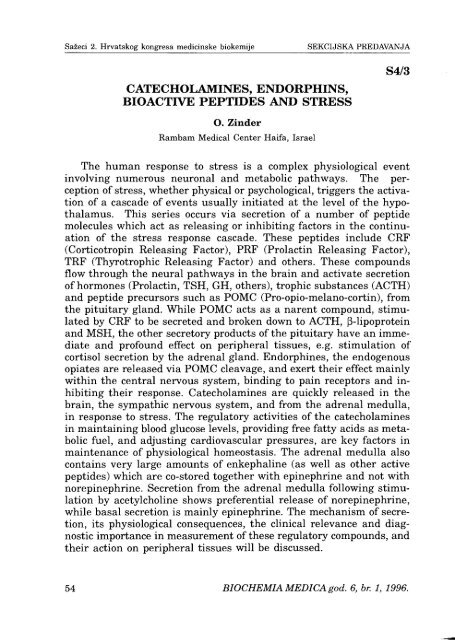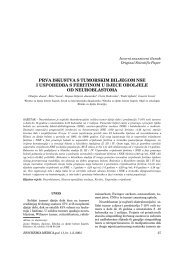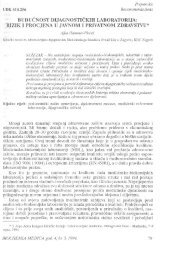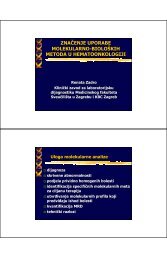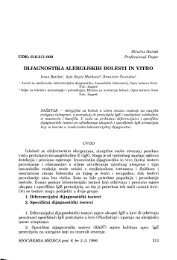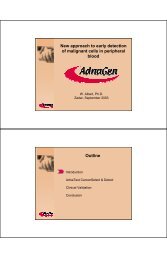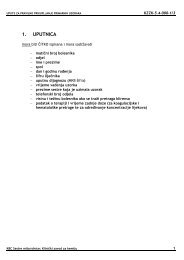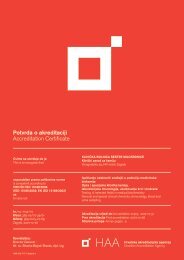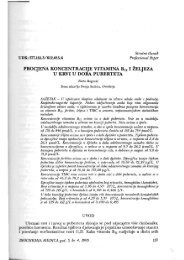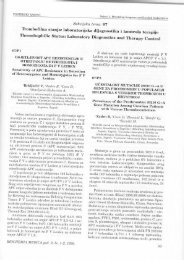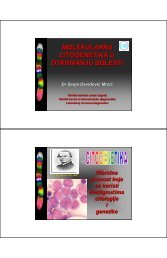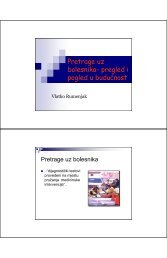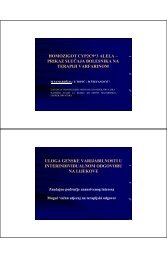Sažeci 2. Hrvatskog kongresa medicinske biokemije - Klinički zavod ...
Sažeci 2. Hrvatskog kongresa medicinske biokemije - Klinički zavod ...
Sažeci 2. Hrvatskog kongresa medicinske biokemije - Klinički zavod ...
You also want an ePaper? Increase the reach of your titles
YUMPU automatically turns print PDFs into web optimized ePapers that Google loves.
<strong>Sažeci</strong> <strong>2.</strong> <strong>Hrvatskog</strong> <strong>kongresa</strong> <strong>medicinske</strong> <strong>biokemije</strong><br />
SEKCIJSKA PREDAVANJA<br />
CATECHOLAMINES, ENDORPHINS,<br />
BIOACTIVE PEPTIDES AND STRESS<br />
S4/3<br />
O. Zinder<br />
Rambam Medical Center Haifa, Israel<br />
The human response to stress is a complex physiological event<br />
involving numerous neuronal and metabolic pathways. The perception<br />
of stress, vvhether physical or psychological, triggers the activation<br />
of a cascade of events usually initiated at the level of the hypothalamus.<br />
This series occurs via secretion of a number of peptide<br />
molecules which act as releasing or inhibiting factors in the continuation<br />
of the stress response cascade. These peptides include CRF<br />
(Corticotropin Releasing Factor), PRF (Prolactin Releasing Factor),<br />
TRF (Thyrotrophic Releasing Factor) and others. These compounds<br />
flow through the neural pathways in the brain and activate secretion<br />
of hormones (Prolactin, TSH, GH, others), trophic substances (ACTH)<br />
and peptide precursors such as POMC (Pro-opio-melano-cortin), from<br />
the pituitary gland. While POMC acts as a narent compound, stimulated<br />
by CRF to be secreted and broken down to ACTH, P-lipoprotein<br />
and MSH, the other secretory products of the pituitary have an immediate<br />
and profound effect on peripheral tissues, e.g. stimulation of<br />
cortisol secretion by the adrenal gland. Endorphines, the endogenous<br />
opiates are released via POMC cleavage, and exert their effect mainly<br />
within the central nervous system, binding to pain receptors and inhibiting<br />
their response. Catecholamines are quickly released in the<br />
brain, the sympathic nervous system, and from the adrenal medulla,<br />
in response to stress. The regulatory activities of the catecholamines<br />
in maintaining blood glucose levels, providing free fatty acids as metabolic<br />
fuel, and adjusting cardiovascular pressures, are key factors in<br />
maintenance of physiological homeostasis. The adrenal medulla also<br />
contains very large amounts of enkephaline (as well as other active<br />
peptides) which are co-stored together with epinephrine and not with<br />
norepinephrine. Secretion from the adrenal medulla following stimulation<br />
by acetylcholine shows preferential release of norepinephrine,<br />
vvhile basal secretion is mainly epinephrine. The mechanism of secretion,<br />
its physiological consequences, the clinical relevance and diagnostic<br />
importance in measurement of these regulatory compounds, and<br />
their action on peripheral tissues will be discussed.<br />
54 BIOCHEMIA MEDICA god. 6, br. 1, 1996.


